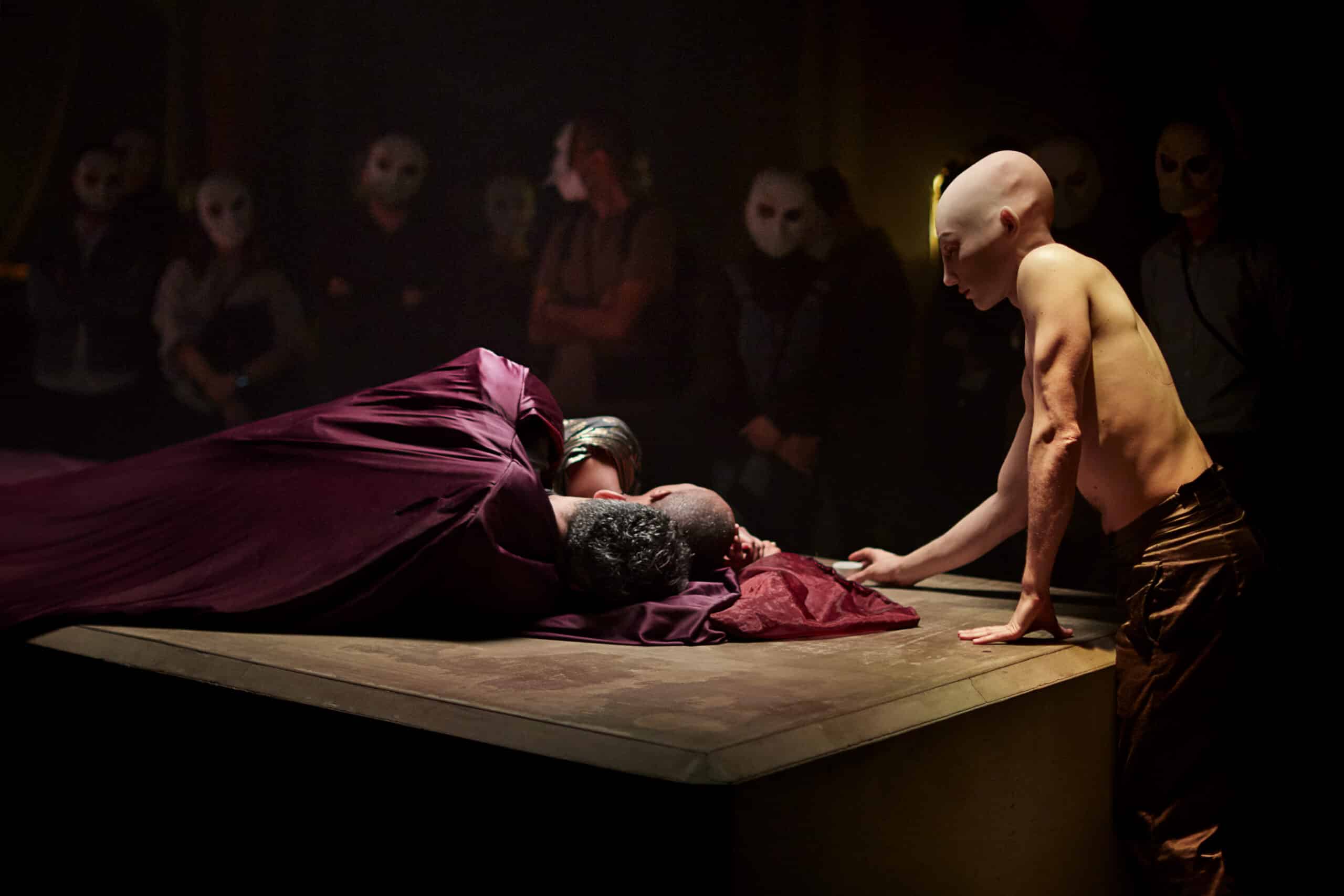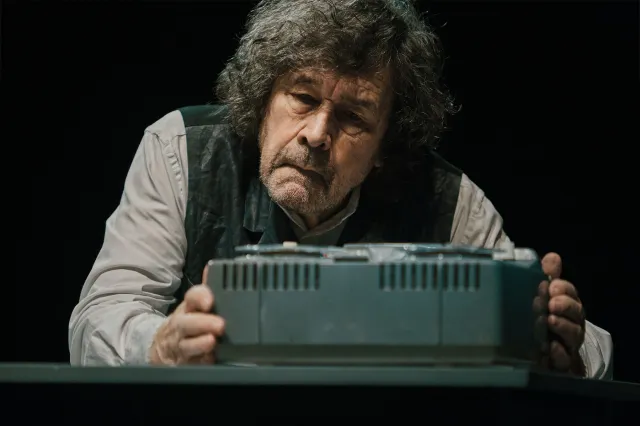Punchdrunk
Starting a review with a dramatic statement is a writer’s right. Shock, explain, and recapitulate. It works very well. So well it has almost become cliché…. But will I do it again? Punchdrunk’s extension of the run of The Burnt City until September 2024 rather forces me doesn’t it?
I hate immersive theatre. This isn’t your pedestrian disdain, no no. This is a well-explored and researched dislike born from years of wandering around badly lit churches or warehouses. Unable to take notes, rest my tired toes, get a drink, or ever be completely comfortable. Knowing full well that something is going to loom around the next peeling corner. A jump, a ghost, or a piece of badly choreographed movement. Hate it.
Until (did you see the double back coming you bright thing?) I was pressured by my then-boyfriend (an actor himself) into seeing Punchdrunk’s The Drowned Man. Starting in 2000 the company was well on its way to stardom at this point. Led by artistic director Felix Barrett, they run now simultaneously on 3 continents, have won glittering accolades, and work with the best in British theatre (ENO, The National) and beyond. But this was 2013, a simpler time, and although it was phenomenal since then I have sustained my dislike of the theatrical genre. Reinforced each time by flits into dismal haunted houses and site-specific history plays outside the Poundland on Camden high street (I kid you not).
Punchdrunk is an exception to almost every rule. They have scope, money, vision, money, talented actors, and lastly did I mention money? Becoming an international if not quite household name the tickets are almost as coveted (and expensive) as The Playhouse’s Cabaret, and I would argue slightly better value for money!
The problem arises with how to describe a tale so vast, so individual, like building your own theatrical adventure, to the uninitiated reader (yourself). This is my attempt.
The theme is the sacking of Troy, the burning city of Homer’s classical Greek epic, recontextualised (vaguely) in the 1st or 2nd world war. Housed in the sprawling industrial gloom of the company’s new home, a warehouse in Woolwich Arsenal. If a theatre show could ever hike up housing prices this would be the one.
Masks, both covid and theatrical are donned, phones are locked in little bags, and from an opium den-style bar (that you will have trouble finding later but really should) you are let loose. Well not before the facilitators try their best to pry you from your loved ones in an attempt at personal exploration (but I think to reduce clumping).
Clutching your sad little useless phone bag you’re off. Into the dark world of The Burnt City.
I only experienced what I had the energy to explore. A glimpse of multiple narratives traversing and then re-looping through the 100,000 sq ft space. Everything is decorated in exceptional detail, from small concept rooms with hidden handwritten notes, greenhouses, and plush bedrooms, to full battlegrounds complete with massive anti-tank structures. Floors are filled with sand, and hidden passages seem to tunnel away from every closed door (so try them all). Designers Felix Barrett, Livi Vaughan, and Beatrice Minns and their team have created an Instagram heaven (ironic considering the phone cages) and set builders paradise, down to the smallest hidden draw filled with papers and objects, background on the story being told. It is almost frustrating as you will never have enough time (or in our case stamina) to see everything, it’s all snatched glimpses never the full beautiful picture.
F9, Ben Donoghue, and Felix Barrett have worked hard to make sure that despite the unruly paths cut by the masked audience every moment is divinely lit. Within the Greek/Troy section classical music especially Gabriel Faure’s Requiem swells at the big must-see moments. Stick around the main stairwell or the upstairs gallery if you want to capture the most recognisable moments from the Greek classic.
Relying on movement over dialogue, a totally understandable choice for a show where the audiences very rarely see the whole of any one scene. One bloody but delightful highlight is Agamemnon’s return home from Troy to his “loving” Clytemnestra. Blood, nudity, and a shower erupting from the roof give us a fresh new take on this famous scene, and it is so close, you trick yourself into smelling the iron tang of blood.
Little moments also ring with quiet delicacy. While desperately hunting for the bar we stumble across an audience member being poured a drink of saki in a Japanese-style izakaya. This moment is so intimate everyone else apart from the two leave the space. The feeling that we are intruding on a moment not meant for our eyes is palatable. Now you would never get that in your classic sat-down-with-a-tub-of-icecream style theatre experience, would you?
When it works it is exploring another world, no metaphor needed. Filled with mournful Trojans and nightmarish circus performers. Wandering around the corners you get swept up, rushing after characters you are interested in, tense and a little scared in dark corridors, or literally crawling into hidden spaces. You get lost both geographically and emotionally. It’s extraordinary, impressive, and just a little too much.
But as Punchdrunk is the best of the best they are skewered by their own success. The battleground half of the many rooms and corridors is the most effective. Themed around Homer’s famous tale, we have war, betrayal, armor, and honour. But tacked onto this is a rather confusing circusy story, 1920s in setting, seemingly unconnected to any idea of a burnt city. Characters (in my experience) don’t cross the threshold, and the fun house’s brand of spooky is by far the least interesting and most waring. Although it is next to the bar so that’s a nice help.
Furthermore, the issues I have with immersive theatre do raise their hands in quiet objection. There is a style of acting that involves wide eyes, splayed fingers, and meaningful glances. This Tim-Burton-does-theatre aims for an unnerving and dreamlike quality. Although serving the company well over the last two decades it gets a little tiring after almost 3 hours.
Now I have been through the ordeal/experience I can give you my top tips for how to get the most out of your burnt city. After all, what is a review?
It is heated so don’t wear loads of layers or else you (like I) will feel suffocated by your own cotton accessories.
Throw away any clinging idea of narrative or even at points character. You will never know what’s going on, embrace that. The best you will do is pat yourself well on the back when you see two soldiers exchange a rose and longing hug and assume you have found Achilles and Patroclus. Well done you, then all sense is swept away once again. Become the chaos, and live within it.
Re-find the bar regularly. There is a cabaret that is the only funny part of the show, and a nice break from all the longing glances and earnest thrashing. Every section is cyclical, so if you miss it the first time after a cheeky cocktail you’ll find it again.
If you can, wear a Hellenic-style toga costume like one of my fellow audience members. Not only will you pull focus in the best way, but throughout people will mistake you for an actor, adding your own sprinkle of chaos into the mix. See point two above for reference. Although of course, any audience outfit will pale in comparison with David Israel Reynoso’s rippling silks, and structured armored clothes, just perfect.
Lastly, when you’re done, you’re done. Don’t (as I did) push yourself around when you have hit your saturation point. Like a sodden sponge, you’re not going to get wetter (metaphorically speaking). The experience is unique, sadly a little overpriced, and exemplary. A world that lives and breathes and bleeds right in front of your eyes, you could reach out and touch it (although with the actors please don’t). Yet seeing as none of it makes much sense narrative-wise, don’t push yourself to see it all. Punchdrunk’s blessing and curse is that you never will.
Get yourself a ticket, it is NOT to be missed, click here!



